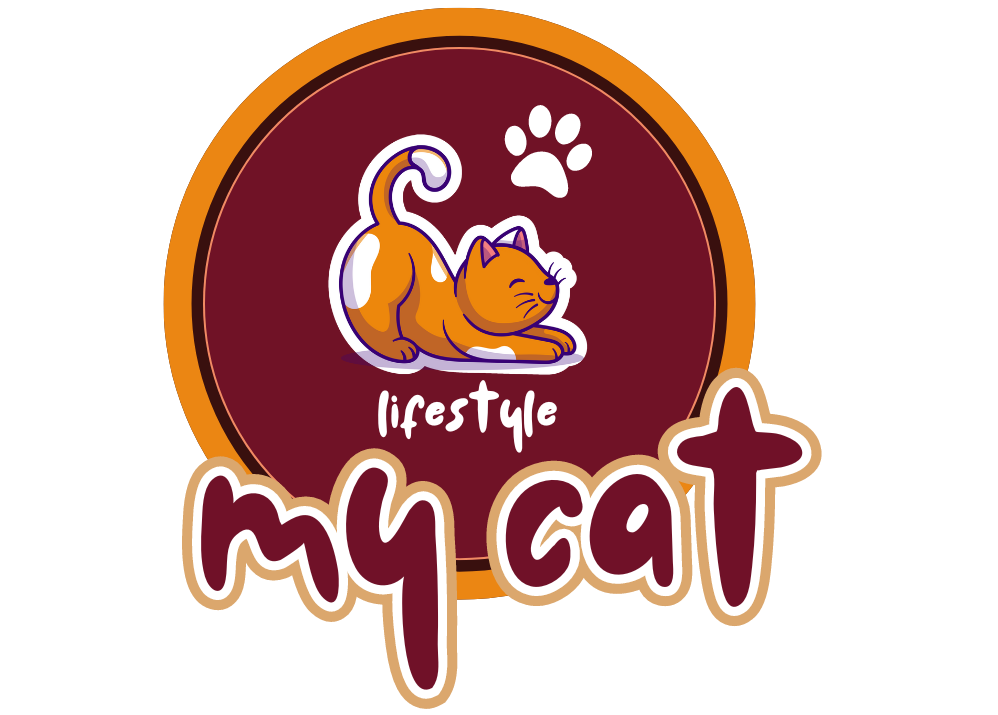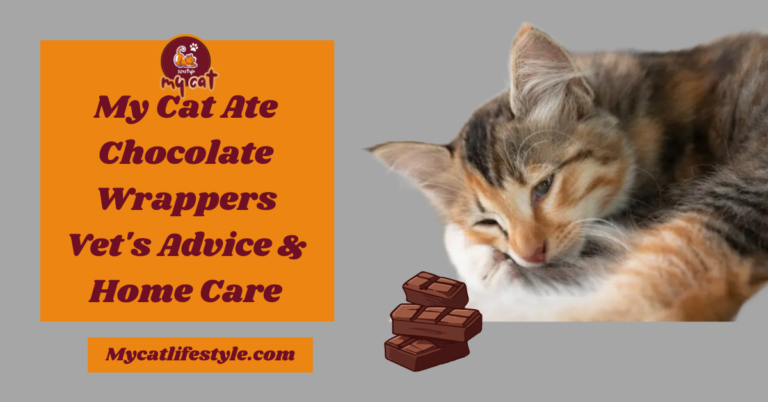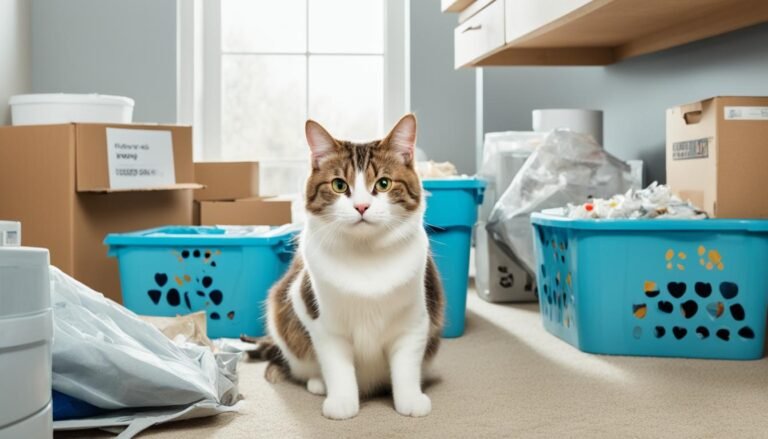My Cat Ate a Whole Bag of Treats: Prevention and Care Tips
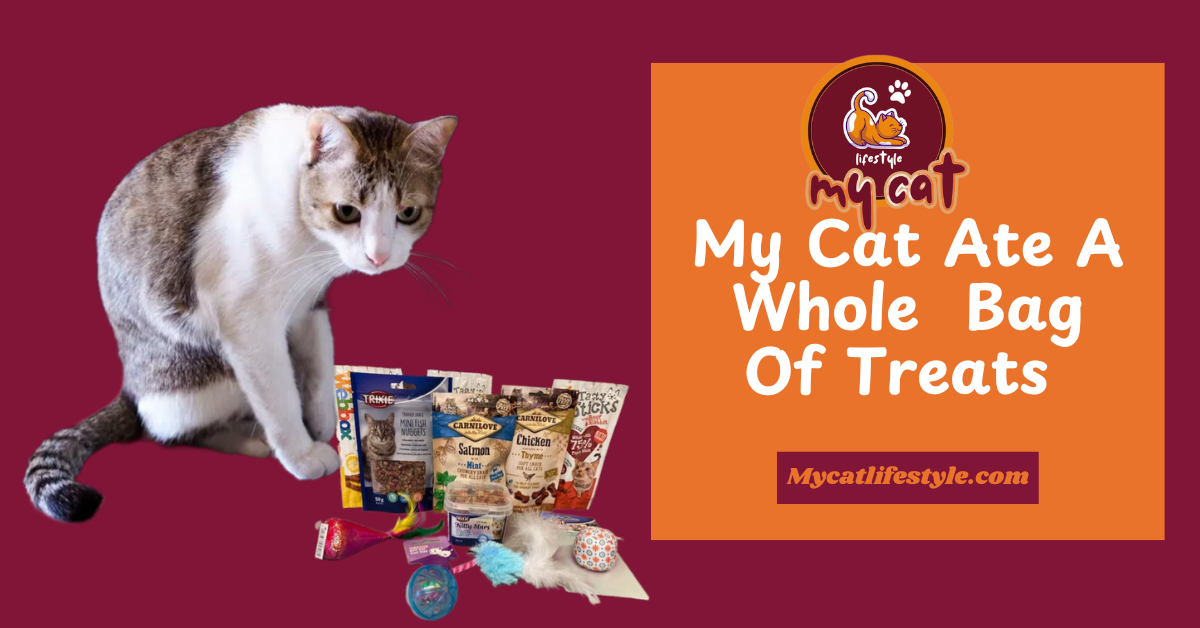
One morning, I discovered that my kittens had indulged in a sneaky feast where “My Cat Ate a Whole Bag of Treats.” They had accessed and completely emptied a 6.3oz bag of Temptations Kitten Chicken and Dairy treats. Although they are regularly nourished with Whole Hearted Grain-Free Chicken Recipe Kitten Food, their curiosity had led them to this treat binge.
Despite my concerns, they showed no signs of discomfort or illness like diarrhea, remaining playful and active. This incident underscored the importance of securely storing pet treats and maintaining vigilant oversight of their diets to prevent health issues from such indulgences.
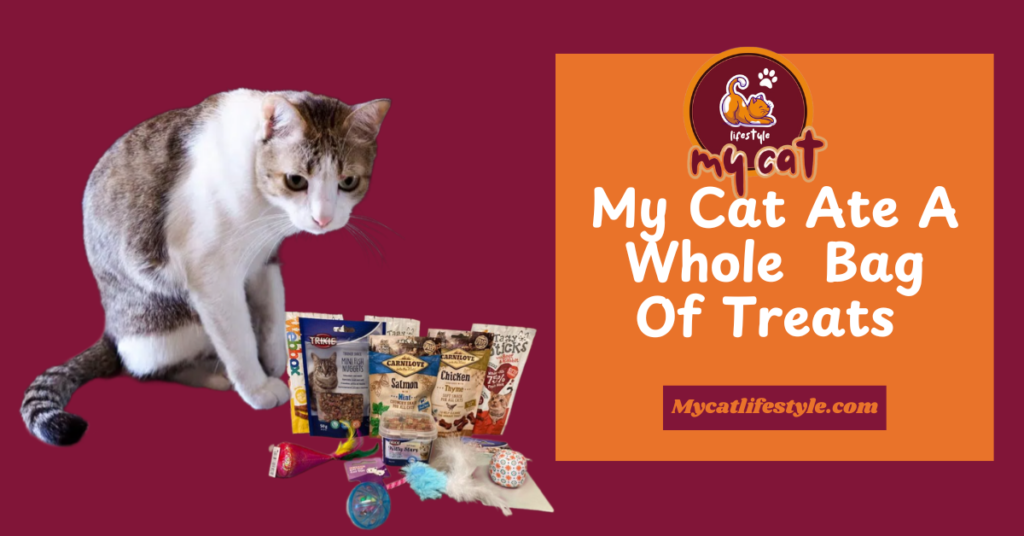
My Cat Ate a Whole Bag of Treats
Imagine coming home to find an empty bag of Temptations treats, a favorite among feline snack choices. Many pet owners might wonder: “Can my cat really eat an entire bag of treats in one sitting?” The answer isn’t straightforward, as it heavily depends on the size of the bag and the size of the treats. For instance, a small 6.3oz bag might be within the realm of possibility for a particularly determined or hungry cat.
However, it’s essential to consider the possible consequences of such an indulgence. Overeating treats can lead to various health issues, from minor diarrhea to more severe digestive upset. If you ever discover your cat has helped themselves to too many treats, it’s wise to monitor their behavior closely.
If they start acting normal and show no signs of distress, they might have dodged a bullet this time. But it’s always a good idea to consult with a vet if you’re unsure, especially if the bag was large and your cat is small or usually a light eater. Ensuring that your pet has access to plenty of fresh drinking water can help mitigate any potential problems from their unexpected snack spree.
In managing your cat’s diet, moderation is key. Treats should not constitute a significant part of their daily caloric intake. Typically, treats should only make up about 10% of a cat’s daily food intake, with the rest provided by a well-balanced diet of dry or wet food. This strategy helps prevent issues such as obesity or nutritional imbalances that can arise from overindulgence in less balanced food options.
Are Treats Bad For Cats?
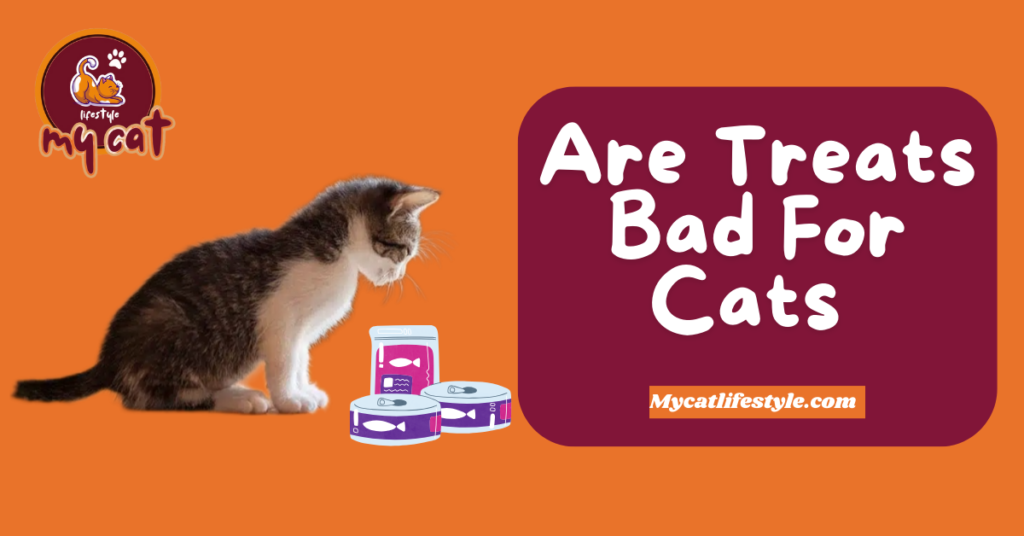
When it comes to treating our furry friends, many of us wonder if we’re doing more harm than good. “Are treats bad for cats?” is a question frequently asked by concerned pet owners. To answer this, it’s essential to understand that, much like humans, cats enjoy a tasty treat every now and then. However, treats should not replace a well-rounded diet that promotes health and vitality.
Cat treats can certainly add variety to your cat’s diet and can be used for training purposes, helping to reinforce good behavior with a special snack. Nonetheless, moderation is crucial. While not inherently bad, treats can become fattening if given too freely, especially those high in calories or lacking nutritional balance. This article aims to provide guidance on how to integrate treats into your cat’s diet responsibly. By ensuring treats are given as part of a balanced regimen, you help maintain your cat’s health, allowing them to enjoy their snacks without compromising their overall well-being.
Evaluating the Impact of Treats on Feline Health
When it comes to spoiling our cats, treats are often the go-to. But the big question remains: Are cat treats bad for cats? The key lies in understanding the type of treats you choose and how they are fed to your cat. Not all treats are created equal; while some may be packed with high calorie content, others might be healthier, with very little fat content and no additives.
To ensure that treats remain a safe and enjoyable part of your cat’s life, it’s crucial to consider the serving suggestion on the packaging. Feeding your cat treats sparingly is essential, as overindulging could lead to nutritional imbalances or prevent them from eating their proper food. Healthy treats, such as Pet Munchies Gourmet Treats or those from brands like Lily’s Kitchen and The Innocent Cat, often provide nutritious goodness without the excess calories. These treats are ideal because they are all natural and ensure that your cat doesn’t get more than what they need. By incorporating such options into your cat’s diet, you can keep treats to a minimum and maintain a balanced diet that supports their overall health.
Can treats make a cat sick?
It’s a simple answer when it comes to whether cat treats can make a cat sick: yes, they can if not managed properly. Although treats themselves don’t make a cat sick directly, issues arise with overeating or eating too quickly. For a cat, the main thing to consider is the portion size and frequency of these snacks. It’s essential to only feed treats as part of a well-balanced diet where treats only make up about 10% of the cat’s daily intake. The rest should come from their regular wet and dry foods.
If you notice your cat eating too quickly, or if they become sick, it’s important to explore the reasons. Sometimes, the discomfort may be due to upset tummies caused by allergies or another health condition. In such cases, feeding the correct quantities becomes crucial, and you might consider buying a slow feeder or using an interactive game to help slow down their eating.
If the problem persists, or if you suspect your cat may have a food intolerance or other health problem, having a chat with your vet to get advice is advisable. This proactive approach ensures your pet remains healthy and happy, avoiding the risk of becoming overweight from too many treats.
Read This Also: Can Cats Have Milk of Magnesia? 7 Essential Tips for Safe Use
Are cat treats fattening?
When pondering whether cat treats are fattening, it’s akin to humans occasionally indulging in cake: fine every once in a while but problematic if it becomes a daily habit. Treats, much like any type of food, can become fattening when fed in the wrong quantities. For cats, the occasional treat won’t lead to noticeable weight gain, but habitual overfeeding will certainly see the pounds piling on. To keep your feline healthy, it’s crucial to adhere to the manufacturer’s guidelines and ensure treats are just a small, controlled part of a balanced diet.
If you’re worried about the calories and health implications of your cat’s treats, there are alternatives like the Catit Senses 2.0 Grass Planter. This product offers Cat Grass, an indoor grass that’s completely healthy for cats to graze on, aiding in digestion and helping to prevent hairballs. It’s a brilliant option for those concerned about their cat gaining weight from too many treats. Furthermore, such grass can provide a useful distraction from less desirable munching habits, such as going after your main houseplants.
How often should you give a cat treats?
When deciding how often you should give a cat treats, the specific treats you choose play a crucial role. For instance, popular brands like Dreamies cat treats recommend a serving suggestion of up to 20 treats per day, whereas Innocent Cat Treats suggest a more conservative limit of up to 6 per day. This variation highlights why it’s important to check the serving suggestion on the packaging of the specific treats chosen for your pet.
The frequency and quantity should depend on factors like your cat’s activity level, dietary needs, and overall health. Moderation is key, as even healthy treats can contribute to weight gain if dispensed too liberally. Always incorporate treats into a well-balanced diet to ensure they provide pleasure without health compromises. This approach helps maintain your cat’s interest and engagement in their regular meals, making treats a delightful exception rather than a regular expectation.
When Should You Give Your Cat Treats?
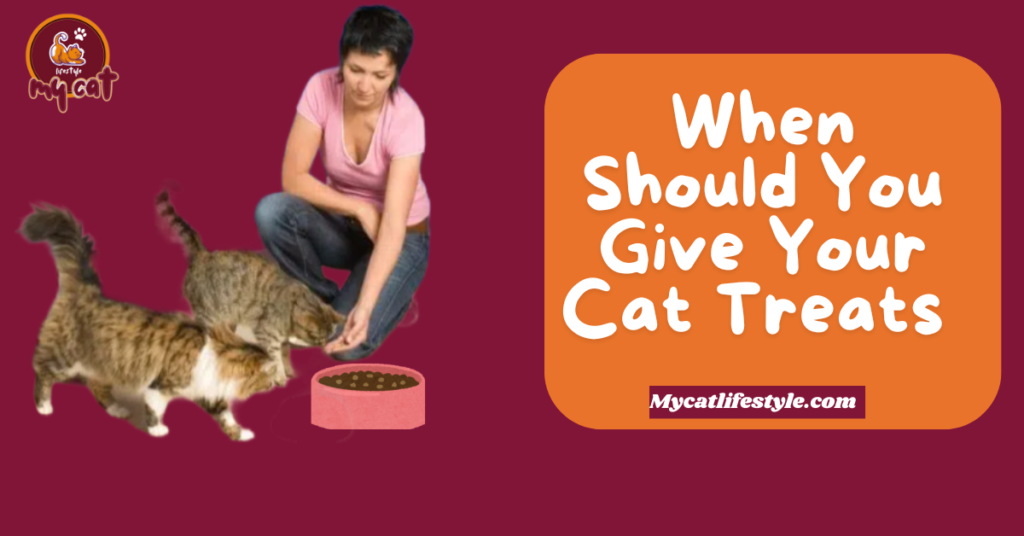
Deciding when to give your cat treats often comes down to your lifestyle and your cat’s habits. Some owners choose to feed their cats one or two treats at various times throughout the day, while others wish to serve them in one or two servings at the beginning and end of the day. No matter your approach, it’s essential to keep treats as a special part of your cat’s routine.
Don’t forget, treats should be served as a snack or used as a reward during training sessions. For example, you might wish to serve them only when your cat shows good behaviour, like using the litter tray or sleeping in their bed. Remember, the same feeding guidelines stand whether the treats are for training or as a snack. Don’t go over the recommended feeding guide and always feed as part of a complete diet to ensure your cat stays healthy and happy.
Read This Also: How to Cat-Proof a Fish Tank: Vet Approved Tips & Tricks
Why Your Cat Is Only Eating Treats
Many people think their cat can’t eat a whole bag of treats in one sitting, but that’s not always the case. Some cats can easily demolish a whole bag of treats in a matter of minutes, while other cats might eat a small portion at a time, then rest before consuming the rest of the treats. It’s important to remember that treats should be given in moderation. Obesity and health problems can be caused by eating too many treats at once, making it essential to limit treats to a small handful once a day.
While treats might be enjoyable, they are like junk foods for cats—fine from time to time, but they shouldn’t be the sole source of nutrition. A cat won’t get the nutrients they need from treats alone to maintain a healthy body. Therefore, it’s crucial to include a variety of food in their diet, like cat milk, catnip, cooked meat, fish, or other catnip treats to ensure they get all the necessary calories and nutrients.

Exploring Underlying Causes
Cat treats are often used as special snacks because they taste better than regular kibble. Your cat might be holding out for them because they’ve gotten used to the taste and texture of these special snacks.
- Keep in mind that cat’s senses are sharper and they can detect the slightest change in the texture, flavor, or smell of their regular cat food.
- Sometimes, a manufacturer might have changed the recipe, or the moisture levels might be different due to a new production method.
- This can lead to your cat refusing their usual food because it smells or tastes odd. If your cat has never been a picky eater but now shows a sudden appetite change, it might be due to stress or anxiety.
- Cats are creatures of habit, and big changes at home, like a new pet or a housemate, or even something as small as rearranging their litter box, can throw them off balance.
- This stress can reduce their appetite for anything except the most tempting treats.
- Additionally, if your cat is not eating properly due to an underlying health issue like dental problems, they may rely on soft treats instead of their usual food.
- It’s always wise to take your cat to the vet for a check-up if you’re concerned about potential health issues affecting their appetite.
How to Get Your Cat to Eat Their Food Again
If your cat has stopped eating their regular food after indulging in a whole bag of treats, you may need to take a few steps to get them back on track. Start by going cold turkey on the treats. Stop giving them any treats for a week or two to help them realize that kibble is their only option. During this time, ignore any begging and never give in close to mealtime. When you start reintroducing treats, make sure to give treats with a purpose, such as rewards for good behavior. This helps your cat understand that treats are special and not a substitute for their main meals.

To make their regular meals more appealing, consider rotating cat food flavors. Switch up the kibble flavors from time to time by trying smaller trial packages from pet stores or scoops of favorite brands from friends or family. Introduce the new food slowly to prevent stomach upset—mix a little new kibble with the old, gradually increasing the new and reducing the old until they’ve completely switched.
Also, try to make mealtime exciting by adding a splash of broth, hot water, salmon oil, or lactose-free milk to the food. You can also use puzzle feeders or interactive toys to make eating more fun, or stuff and freeze their food in a Kong toy to keep them engaged. Ensuring your cat feels safe and comfortable during meals is crucial, so create a peaceful environment with a cozy spot and minimal distractions from other pets or children. Establishing a strict feeding routine by feeding at the same time every day can help regulate their appetite and metabolism, making mealtime something they look forward to.
Frequently Asking Questions
What Happens If a Cat Eats Too Many Treats?
If a cat eats too many cat treats, it can lead to several issues, such as digestive upset, weight gain, and even more severe health problems if it becomes a habit. Overindulging can cause your cat to feel uncomfortable, and they might experience diarrhea or vomiting. It’s important to monitor their behavior and ensure they have access to fresh water. If symptoms persist, consulting your vet is recommended.
What Should I Do If My Cat Ate a Whole Bag of Temptations?
If your cat ate a whole bag of Temptations, the first thing to do is to stay calm and assess the situation. While it’s not ideal, most cats will be okay after such an incident. Keep an eye on them for any signs of distress, like vomiting, diarrhea, or lethargy. Make sure they drink plenty of water and avoid giving them more treats for a while. If you’re worried or notice unusual behavior, contact your vet for advice.
Is It Normal for Cats to Swallow Treats Whole?
Yes, it is quite normal for cats to swallow treats whole. Cats don’t always chew their food thoroughly, especially when it comes to smaller items like treats. However, if you notice your cat frequently swallowing large treats whole, consider breaking them into smaller pieces to prevent any choking risk and make the treats easier to digest.
What Happens If My Cat Eats a Whole Bag of Catnip Treats?
If your cat eats a whole bag of catnip treats, they might become overly excited or, in some cases, a bit nauseous. While catnip is generally safe for cats, too much can cause stomach upset or make them feel unwell. Observe their behavior, and if they seem off, provide plenty of water and a quiet place to rest. As always, if you’re concerned, reach out to your vet for guidance.
Conclusion
If your cat ate a whole bag of treats, it’s important to stay calm and monitor their behavior closely. While an occasional treat is fine, overeating can lead to digestive issues and other health concerns. Always ensure that treats are given in moderation, and if you’re ever in doubt, consult with your vet to keep your furry friend safe and healthy. By managing treat intake and keeping a balanced diet, you can help prevent future incidents and ensure your cat’s well-being.
